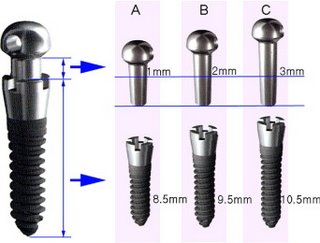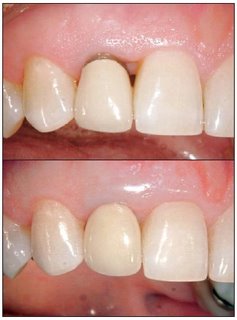Skyce, Dental Meetings, Mini Implants and More
Three million computers on Internet hit by Virus/worm
A worm that spreads through low security networks, memory sticks, and PCs without the latest security updates is posing a growing threat to users.
The malicious program, known as Conficker, Downadup, or Kido was first discovered in October 2008.
Although Microsoft released a patch, it has gone on to infect 3.5m machines.
Experts warn this figure could be far higher and say users should have up-to-date anti-virus software and install Microsoft's MS08-067 patch. Full Story
Tooth Jewelery or Skyce

Skyce is a range of crystal glass tooth jewellery. Teenagers like it specially.
The stones are bonded to the labial surfaces of natural upper anterior teeth without invasive
preparation. For Step by Step Instructions for its placement- CLICK HERE
Two-component mini-implant as an efficient tool for orthognathic patients
AJODO Jan 2009
A new type of orthodontic mini-implant called the C-implant can be an effective alternative to conventional 1-component screws in orthognathic patients because of its particular design. Its small size and 2-component structure make it easily applicable for various types of difficult intermaxillary fixation cases such as 2-jaw orthognathic surgery, 1-jaw surgery with genioplasty, and orthognathic surgery without presurgical orthodontic treatment. The 2-part design highly resists fracture or deformation during placement and removal, and the long-span head allows the patient to easily attach intermaxillary elastics for traction. This mini-implant can be used not only as an intermaxillary fixation screw but also as anchorage during presurgical and postsurgical orthodontic treatment. Better osseointegration potential of the surface-treated screw part allows it to endure heavy and dynamic forces. In this article, we attempted to show that this mini-implant is a good tool for effective anchorage in presurgical treatment, intermaxillary fixation during surgery, and postsurgical treatment of orthognathic patients.

Medication effects on the rate of orthodontic tooth movement: A systematic literature review - AJODO Dec 2008
Administration of eicosanoids resulted in increased tooth movement, whereas their blocking led to a decrease. Nonsteroidal anti-inflammatory drugs (NSAIDs) decreased tooth movement, but non-NSAID analgesics, such as paracetamol (acetaminophen), had no effect. Corticosteroid hormones, parathyroid hormone, and thyroxin have all been shown to increase tooth movement. Estrogens probably reduce tooth movement, although no direct evidence is available. Vitamin D3 stimulates tooth movement, and dietary calcium seemed to reduce it. Bisphosphonates had a strong inhibitory effect.
Dental Meetings- Trade and scientific, India and world
Click here to see the exciting year ahead, take your pick and attend to learn new technquies and buy dental materials and equipemnets at Bargains CLICK HERE to see listing

Microsurgical Technique for Augmentation of the Interdental Papilla: Three Case Reports
(Int J Periodontics Restorative Dent 2008;28:543–549.)
The loss of interdental papillae as the result of trauma or inflammatory periodontal disease creates a significant challenge in the esthetic zone. See pre post pic on left side. Conventional surgical techniques are unpredictable because of small working spaces and limited blood supply to the area. Vertical releasing incisions can further jeopardize vascular channels and leave unattractive scarring upon healing. The application of microscopes and microsurgical instruments presents a new frontier for predictable esthetic results. This paper describes a predictable microsurgical technique for reconstruction of the interdental papillae. Request full paper by emailing to icdr@hotmail.com
Discovery: New Tool To Improve Oral Hygiene At The University Of Liverpool
Scientists at the University of Liverpool have developed a new dental product to identify plaque build-up in the mouth before it is visible to the human eye. The toothbrush-sized product has a blue light at its tip, which, when shone around the mouth and viewed through yellow glasses with a red filter, allows plaque to be seen easily as a red glow. The device, produced in collaboration with dental and healthcare developers, Inspektor Research Systems BV, has been designed for everyday use in the home.
Dentists currently use disclosing agents in tablet form to uncover tooth decay and plaque but these often stain the mouth and taste unpleasant. The new product, known as Inspektor TC, will be particularly useful for those who are vulnerable to dental diseases such as children and the elderly. Full Story
CLICK HERE ONLY if U LOVE PHOTOGRAPHY, feast for your eyes

A worm that spreads through low security networks, memory sticks, and PCs without the latest security updates is posing a growing threat to users.
The malicious program, known as Conficker, Downadup, or Kido was first discovered in October 2008.
Although Microsoft released a patch, it has gone on to infect 3.5m machines.
Experts warn this figure could be far higher and say users should have up-to-date anti-virus software and install Microsoft's MS08-067 patch. Full Story
Tooth Jewelery or Skyce

Skyce is a range of crystal glass tooth jewellery. Teenagers like it specially.
The stones are bonded to the labial surfaces of natural upper anterior teeth without invasive
preparation. For Step by Step Instructions for its placement- CLICK HERE
Two-component mini-implant as an efficient tool for orthognathic patients
AJODO Jan 2009
A new type of orthodontic mini-implant called the C-implant can be an effective alternative to conventional 1-component screws in orthognathic patients because of its particular design. Its small size and 2-component structure make it easily applicable for various types of difficult intermaxillary fixation cases such as 2-jaw orthognathic surgery, 1-jaw surgery with genioplasty, and orthognathic surgery without presurgical orthodontic treatment. The 2-part design highly resists fracture or deformation during placement and removal, and the long-span head allows the patient to easily attach intermaxillary elastics for traction. This mini-implant can be used not only as an intermaxillary fixation screw but also as anchorage during presurgical and postsurgical orthodontic treatment. Better osseointegration potential of the surface-treated screw part allows it to endure heavy and dynamic forces. In this article, we attempted to show that this mini-implant is a good tool for effective anchorage in presurgical treatment, intermaxillary fixation during surgery, and postsurgical treatment of orthognathic patients.

Medication effects on the rate of orthodontic tooth movement: A systematic literature review - AJODO Dec 2008
Administration of eicosanoids resulted in increased tooth movement, whereas their blocking led to a decrease. Nonsteroidal anti-inflammatory drugs (NSAIDs) decreased tooth movement, but non-NSAID analgesics, such as paracetamol (acetaminophen), had no effect. Corticosteroid hormones, parathyroid hormone, and thyroxin have all been shown to increase tooth movement. Estrogens probably reduce tooth movement, although no direct evidence is available. Vitamin D3 stimulates tooth movement, and dietary calcium seemed to reduce it. Bisphosphonates had a strong inhibitory effect.
Dental Meetings- Trade and scientific, India and world
Click here to see the exciting year ahead, take your pick and attend to learn new technquies and buy dental materials and equipemnets at Bargains CLICK HERE to see listing

Microsurgical Technique for Augmentation of the Interdental Papilla: Three Case Reports
(Int J Periodontics Restorative Dent 2008;28:543–549.)
The loss of interdental papillae as the result of trauma or inflammatory periodontal disease creates a significant challenge in the esthetic zone. See pre post pic on left side. Conventional surgical techniques are unpredictable because of small working spaces and limited blood supply to the area. Vertical releasing incisions can further jeopardize vascular channels and leave unattractive scarring upon healing. The application of microscopes and microsurgical instruments presents a new frontier for predictable esthetic results. This paper describes a predictable microsurgical technique for reconstruction of the interdental papillae. Request full paper by emailing to icdr@hotmail.com
Discovery: New Tool To Improve Oral Hygiene At The University Of Liverpool
Scientists at the University of Liverpool have developed a new dental product to identify plaque build-up in the mouth before it is visible to the human eye. The toothbrush-sized product has a blue light at its tip, which, when shone around the mouth and viewed through yellow glasses with a red filter, allows plaque to be seen easily as a red glow. The device, produced in collaboration with dental and healthcare developers, Inspektor Research Systems BV, has been designed for everyday use in the home.
Dentists currently use disclosing agents in tablet form to uncover tooth decay and plaque but these often stain the mouth and taste unpleasant. The new product, known as Inspektor TC, will be particularly useful for those who are vulnerable to dental diseases such as children and the elderly. Full Story
CLICK HERE ONLY if U LOVE PHOTOGRAPHY, feast for your eyes


0 Comments:
Post a Comment
<< Home